CIVIL TECHNOLOGY PAPER GRADE 12 MEMORANDUM - NSC PAST PAPERS AND MEMOS NOVEMBER 2016
Share via Whatsapp Join our WhatsApp Group Join our Telegram GroupCIVIL TECHNOLOGY PAPER
GRADE 12
NSC EXAM PAPERS AND MEMOS
NOVEMBER 2016
MEMORANDUM
QUESTION 1: CONSTRUCTION, SAFETY AND MATERIAL
1.1.1 The worker should have ensured that:
- the grinder and grinding blade/disc were inspected for defects before use. √
- the angle grinder is used for the intended purpose only. √
- correct blade is correctly fitted for the purpose.
- he/she is trained to use the machine correctly.
- do not force the tool. (2)
ANY TWO OF THE ABOVE OR ANY OTHER ACCEPTABLE ANSWER
1.1.2
- Hard hat/safety helmet √
- Safety goggles/goggles √
- Overall
- Safety gloves/gloves
ANY TWO OF THE ABOVE (2)
1.1.3 The machine makes a loud noise √ that will damage your hearing. √ It is the rule or regulation on a building site to protect the hearing of workers. ANY OF THE ABOVE (2)
1.1.4
- dust mask
- face shield
- ear protection/ear plugs/ear muffs
- safety shoes √ (1)
ANY ONE OF THE ABOVE
1.2
1.2.1
- Water √
- Patent sealer
- Wet sand
- Hessian
- Canvas or protective covering
- Plastic sheeting
- Straw
- Waterproof paper
ANY ONE OF THE ABOVE (1)
1.2.2 7 to 28 days √ (1)
1.3 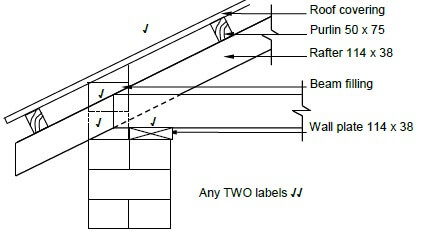 Any TWO labels √√
Any TWO labels √√
ASSESSMENT CRITERIA | MARK | CANDIDATE'S MARK |
Roof covering correctly drawn | 1 | |
Beam filling correctly drawn | 2 | |
Wall plate correctly drawn | 1 | |
Any TWO labels | 2 | |
TOTAL | 6 | (6) |
Single line for roof covering is acceptable.
Wall plate in good proportion acceptable.
1.4
- More battens are used √
- More roof trusses are used to carry weight of tiles √
- Clay/concrete tile more expensive than corrugated iron sheeting
- More labour intensive
- Needs roof underlay (2)
ANY TWO OF THE ABOVE
1.5
- Tiles /cladding√
- Paint (1)
ANY ONE OF THE ABOVE
1.6
- Tiles last longer/easy to clean/ water resistant √
- Paint does not last as long as tiles, easy to clean.
- Tiles/paint gives attractive/decorative appearance.
- Protect plaster.
ANY ONE OF THE ABOVE (1)
1.7
1.7.1 Channel-iron/U beam √ (1)
1.7.2 Exposed steel is prone to rust if not treated. √ (1)
1.7.3
- Paint the metal. √
- Can be galvanised.
- Powder coating/ epoxy coating.
- Can be covered with oil. (1)
ANY ONE OF THE ABOVE
1.7.4
- Channel iron is used for bracing or as joists. √
- Frame of steel structures/struts/roof structures (1)
OR ANY OTHER ACCEBTABLE ANSWER
1.8
1.8.1
- Three quarter bat/brick
- 165 mm x 110 mm. √ (1)
ANY ONE OF THE ABOVE
1.8.2 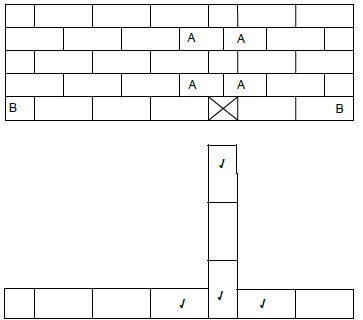 (4)
(4)
ASSESSMENT CRITERIA | MARK | CANDIDATE'S MARK |
Stretcher course | 2 | |
Header course | 1 | |
Correctness of T-junction | 1 | |
TOTAL | 4 |
1.9
- Cement fibre ceiling boards √
- Match board ceiling boards
- Steel ceilings
- Gypsum boards
- Knotty pine ceilings
- PVC/plastic/polystyrene ceilings(1)
ANY ONE OF THE ABOVE
1.10
- To allow excess water or damp to escape √
- keeping the inner wall dry
- Ventilation(1)
ANY ONE OF THE ABOVE
[30]
QUESTION 2: ADVANCED CONSTRUCTION AND EQUIPMENT
2.1
2.1.1 D √ (1)
2.1.2 L √ (1)
2.1.3 J √ (1)
2.1.4 H √ (1)
2.1.5 K √ (1)
2.1.6 A √ (1)
2.1.7 M √ (1)
2.1.8 I √ (1)
2.1.9 G √ (1)
2.1.10 B √ (1)
2.2
2.2.1 Chalk line √
USE
- To draw a straight line on a surface, by snapping the line. √
- Lay out walls on foundation.
- Some types can be used as a plumb bobs.
- Draw long lines on floors.(2)
ANY TWO OF THE ABOVE
2.2.2 Try square √
USE
- Marking lines perpendicular to surfaces of materials. √
- Testing squareness, straightness.
- Calibrated blade can be used for measuring.
- As a straight edge to test whether small surfaces are flat and straight. (2)
ANY TWO OF THE ABOVE
2.2.3 Mitre square √
USE
- The mitre can be used to check/end marks 45°angles. √
- Test squareness of corners.
- Test mitre angles/and mark them.
- Marking lines perpendicular to surfaces are flat and straight.
- Testing squareness, straightness of surfaces.
- Calibrated blade can be used for measuring.
- As a straight edge to test whether surfaces of materials. (2)
ANY TWO OF THE ABOVE
2.2.4 Sliding bevel √
USE
- The blade is adjustable for setting out and testing of any angles. √
- Draw inclined or oblique lines as well as for the testing of angles.
- Draw angles other than 90˚
- Copying angles from one surface to another. (2)
ANY TWO OF THE ABOVE
2.3
2.3.1
- The tensile strength of the concrete is compromised. √
- Weakens the structure/ structure will break easily/ collapse. √
- Will not be able to resist heavy loads. (2)
ANY TWO OF THE ABOVE
2.3.2 To strengthen the concrete where it is the weakest against tensile strength. √ (1)
2.3.3
Stirrups strengthen concrete against shear forces. √
Shear forces are the greatest next to the support,
Stirrups resist shear stress. (1)
2.4
2.4.1 Slump test √ (1)
2.4.2 This test is used to test the workability of concrete/ consistency of the concrete √ (1)
2.4.3 For every new/fresh batch of concrete that is mixed √ (1)
2.5
- Cavity walls are to prevent the penetration of water into the wall as they have better water proofing qualities. √
- Cavity walls help to protect the inner wall of a house against moisture. √
- Cavity walls provide insulation against extreme temperatures and noise.
- Avoid expensive external rendering.
- Enable the use of cheaper or alternative materials for the inner construction.
ANY TWO OF THE ABOVE (2)
2.6
2.6.1
A – Compression force/pushing forces √
B – Tensile force/bending forces √
C – Lateral force √ (3)
2.7
2.7.1 Round/circular/cylindrical column formwork √ (1)
2.7.2 Hardboard/plywood/pvc/galvanised/metal sheets √ (1)
2.7.3 Bolt and nut/threaded rods with nuts/clamp √ (1)
2.7.4 Apply form oil/emulsion oil/releasing agents to formwork √ (1)
2.8
- A rib and block floor is very quick to install √ (1)
- quicker than in situ concrete floor
ANY ONE OF THE ABOVE
2.9 
ASSESSMENT CRITERIA | MARK | CANDIDATE'S MARK |
Ribs | 2 | |
Block | 1 | |
Reinforcing on top of or inthe rib | ||
Hollow in block | 1 | |
TOTAL | 5 |
(5)
[40]
QUESTION 3: CIVIL SERVICES
3.1 
Labelling not required (2)
3.2 40/50 mm √ (1)
3.3
3.3.1
A Ventilation pipe/breather pipe/gas escape pipe √ (1)
B Inlet pipe/Inflow pipe/Influent √ (1)
C Settling chamber/Chamber 1 √ (1)
D Discharge chamber/Chamber 2 √ (1)
E Manhole cover/Manhole lid/Cover √ (1)
F Outlet pipe/Effluent √ (1)
3.3.2 The raw sewerage will be broken down by anaerobic/bacterial action. √ (1)
3.3.3
- G allows the liquids to flow from chamber C to chamber D. √
- Will also balance the liquid levels.(1)
ANY ONE OF THE ABOVE
3.3.4 The liquids in D will flow out through F to a French drain. √ (1)
3.3.5 The level of the liquids will be the same. √ (1)
3.3.6
- The water coming from the bath or sink contains soap (chemicals) that is poisonous to the bacteria and will hinder the anaerobic/bacterial process. √ (1)
- It will fill up quicker if the frech drain gets saturated.
ANY ONE OF THE ABOVE
3.4 Storm water systems are used to carry storm water to rivers or low-lying dams. √ (1)
3.5 If you direct storm water into a sewerage system:
- the water will flood the reticulation plant. √
- raw sewerage will overflow into rivers and pollute water sources. √
- it is illegal to direct rain or storm water into a sewerage system.
ANY TWO OF THE ABOVE (2)
3.6 Pressure control valves (pressure-reducing valves) are used to ensure that:
- a constant pressure is maintained in the water installation√
- prevent pipes from bursting
- the pressure rating is in accordance with the pressure rating of the geyser.
ANY ONE OF THE ABOVE (1)
3.7
- An elbow will be used to change the direction of a pipe √
- A T-coupler will be used to split the water supply into two different flow directions/ to combine two different flow directions into one(shower).√ (2)
ANY TWO OF THE ABOVE
3.8 Thermostat √ (1)
3.9 Gravity geyser/Low pressure geyser √ (1)
3.10 Black √ Absorbs the most heat √ (2)
3.11 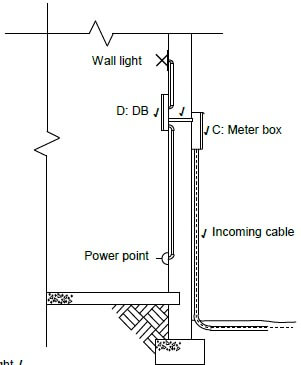
A: Wall light √
B: Power point/Socket outlet/Switch Socket outlet/Plug √(2)
ASSESSMENT CRITERIA | MARK | CANDIDATE'S MARK |
Incoming cable to meter box | 1 | |
Incoming cable to DB | 1 | |
Meter box | 1 | |
Distribution board | 1 | |
TOTAL | 4 | (4) |
ANY OTHER WAY OF INDICATING CONDUIT PIPES
[30]
QUESTION 4: QUANTITIES, MATERIALS AND JOINING
4.1
4.1.1 Door stile √ (1)
4.1.2 50 mm/50 √ (1)
4.1.3 600 √ (1)
4.1.4 3 √ (1)
4.1.5 693 mm/693 √ (1)
4.1.6 1 907 mm/1 907 OR 1 904 mm/1 904 √ (1)
4.1.7 20 mm/20 √ (1)
4.2
4.2.1 B √ (1)
4.2.2 A √ (1)
4.2.3 D √ (1)
4.2.4 D √ (1)
4.2.5 A √ (1)
4.2.6 D √ (1)
4.2.7 C √ (1)
4.3.1
A | B | C | D |
Area to be plastered: | |||
Length of ONE short wall: | |||
Length of ONE long wall | |||
Total length of one short and one long wall | |||
| (3) | |||
2/ | 11,12 | Area of internal walls before deductions: | |
2,7 √ | 60,05 m² √ | (2) | |
1/ | 1,2 | Area of window opening: | |
0,9 √ | 1,08 m² √ | (2) | |
1/ | 2,1 | Area of door opening: | |
0,9 √ | 1,89 m2 √ | (2) | |
Total wall area to be plastered | |||
√ √ √ 60,05 m² – 1,08 m² - 1,89 m² | |||
= 57,08 m² √ need to be plastered (4) |
4.3.2
Volume of plaster: | |||
1/ | √ 57,08 m2 | ||
√ 0,012 m | 0,68 m3 √ | (3) |
If candidates did not use the dimension paper/sheet 2 marks should be deducted
[30]
QUESTION 5: APPLIED MECHANICS
5.1
5.1.1 675 mm² √ (1)
5.1.2 4 800 mm² OR 4 400 mm² √ (1)
5.1.3 400 mm² √ (1)
5.1.4 5 075 mm² √ (1)
5.1.5 30 mm √ (1)
5.1.6 95 mm √ √ (2)
5.1.7 40 mm √ (1)
When the wrong unit were used the learner will be penalised with ONE mark.
Copyright reserved Please turn over
Civil Technology 15 DBE/November 2016 NSC – Memorandum
5.2 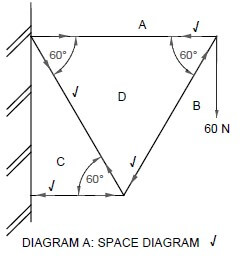
DIAGRAM A: SPACE DIAGRAM 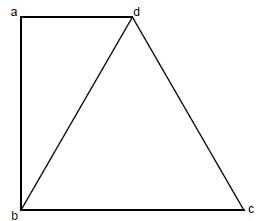
DIAGRAM B: VECTOR DIAGRAM/FORCE DIAGRAM
NOT ACCORDING TO SCALE
USE A MASK TO MARK THIS QUESTION
MEMBER | NATURE | MAGNITUDE |
BC | Strut √ OR --- | 65 N √ (Size to be determined as per vector diagram) OR 0 OR no force |
CD | Tie √ | -------------- |
DA | Tie √ | 32 N √ (Size to be determined as per vector diagram) |
BD | Strut √ | -------------- |
(6)
Tolerance of 1 N to either side
5.3.1 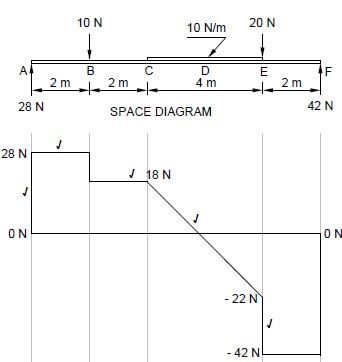
SHEAR FORCE DIAGRAM
USE A MASK TO MARK THIS QUESTION
ASSESSMENT CRITERIA | MARKS | CANDIDATE'S MARK |
Drawing correct | 5 | |
Indicate all values of shear forces on drawing | 1 | |
Correct application of scale | 1 | |
TOTAL | 7 |
5.3.2 Calculated from the left:
BMd: = (28 x 6) - (10 x 4) - (20 x 1) √
= 168 - 40 - 20 √
= 108 Nm √
OR
Calculated from the right:
BMd: = (42 x 4) - (20 x 2) - (20 x 1)
= 168 - 40 - 20
= 108 Nm (3)
[30]
ANSWER SHEET 6.1
NO. | QUESTIONS | ANSWERS | MARKS |
1 | Name the scale used for the site plan. | 1:200 √ | 1 |
2 | State the colour that you will use to indicate the proposed dwelling on the site plan. | Red √ | 1 |
3 | Identify number 1? | Rodding eye √ | 1 |
4 | Identify the line at number 2? | Building line √ | 1 |
5 | Identify number 3 | Sewer pipe/drainpipe √ | 1 |
6 | Determine the distance from the boundary line to the proposed dwelling on the right hand side of the building? | 5 000 mm/5 m √ | 1 |
7 | Identify number 4 | Manhole √ | 1 |
8 | Identify number 5 | Municipal connection √ | 1 |
9 | Draw the roofline of a hipped roof for the building indicated in the next column |
| 4 |
10 | Calculate the perimeter of the proposed dwelling. | 64 000 mm/64 m √ √ | 2 |
11 | What elevation will be closest to Long Street? | West elevation √ | 1 |
TOTAL | 15 |
QUESTION 6: GRAPHICS AND COMMUNICATION
ANSWER SHEET 6.2 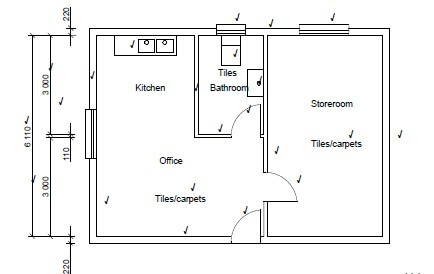
ASSESSMENT CRITERIA | MARKS | LM |
External Walls | 4 | |
Internal Walls | 3 | |
Windows | 3 | |
Doors | 3 | |
Wash basin | 1 | |
Water closet | 1 | |
Double bowl sink | 1 | |
Dimensions | 4 | |
Floor coverings | 2 | |
Application of scale One or two incorrect = 3 | 3 | |
TOTAL | 25 |
NOT TO SCALE: USE A MASK TO MARK THIS QUESTION ONE MARK SHOULD BE DEDUCTED IF JUNCTIONS AT WALLS ARE CLOSED
ONE MARK SHOULD BE DEDUCTED IF INTERNAL DOORS HAVE A WALL BETWEEN THE OPENING
[40]
[200]
